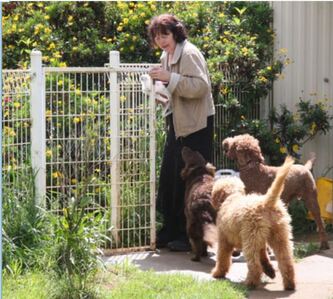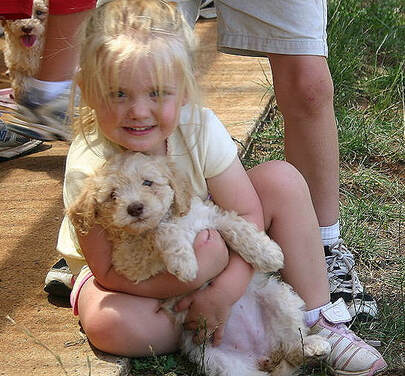What is an Australian Cobberdog?
The Australian Cobberdog is a (Foundation Registered) Pure Breed of dog that was developed in Australia specifically for people with emotional or physical challenges. Another name could well have been Australian Comfort Dog. Some of their root stock were uncorrupted bloodlines gleaned from Australian Labradoodles which were the brainchild of Mellodie Woolley. Others were pure breeds that were consistent in their traits and were infused at specific intervals and for specific reasons.
The Australian Cobberdog was officially recognized by the Master Dog Breeders & Associates (MDBA) in January of 2012. The cobberdog comes in 3 sizes, and has a low to non shedding single fleece coat that is self-cleaning and has no doggy odor even when wet. They are most recognized for their uncanny ability to discern the emotions and physical needs of humans and to adjust their own behaviors accordingly. They should be exceptionally easy to train although they can be too smart for their own good and need a firm but gentle hand early on before they work out ways to outwit first time dog owners. Read more about their origins here
The Australian Cobberdog was officially recognized by the Master Dog Breeders & Associates (MDBA) in January of 2012. The cobberdog comes in 3 sizes, and has a low to non shedding single fleece coat that is self-cleaning and has no doggy odor even when wet. They are most recognized for their uncanny ability to discern the emotions and physical needs of humans and to adjust their own behaviors accordingly. They should be exceptionally easy to train although they can be too smart for their own good and need a firm but gentle hand early on before they work out ways to outwit first time dog owners. Read more about their origins here
Cobberdog Nature
Cheerful and bright, they love to make you laugh and go to extraordinary lengths to make you, all the while looking at you over their shoulder to make sure you are watching! The Intuition of Australian Cobberdogs is possibly the feature that has made them most desired across the globe. They seek human eye contact and seem to gaze deeply into your soul, rather than look 'at' you. It is through this uncanny connection that they know how you are feeling emotionally or physically and adjust their own reaction accordingly.
Cheerful and bright, they love to make you laugh and go to extraordinary lengths to make you, all the while looking at you over their shoulder to make sure you are watching! The Intuition of Australian Cobberdogs is possibly the feature that has made them most desired across the globe. They seek human eye contact and seem to gaze deeply into your soul, rather than look 'at' you. It is through this uncanny connection that they know how you are feeling emotionally or physically and adjust their own reaction accordingly.
They are watching you all the time, weighing up your weaknesses and strengths. And if you don't provide firm and consistent guidelines regarding what you expect from them when they are young, the roles will quickly be reversed until they are training you!
Australian Cobberdogs are the goofy Canine Clowns of the dog world. So you need to be their Leader. Here some ways for you to establish leadership with your puppy from day one:
Ways to establish leadership with your Cobberdog puppy
Walk through a door or gate first after training your puppy to WAIT. Then invite your puppy to follow you.
1. Always walk through a doorway or gateway first. Guide your puppy by using the leash at first, with the instruction - name first then "WAIT". Walk through the door or gate then 'invite' the puppy to come through using its name and the invitation 'come on'. Follow up with praise but not too effusive! Remember that praise is for encouragement or appreciation, After all, you EXPECT your position of pack leader to be respected. (Don't you?)
2. You and your family eat FIRST. In the wild, Leaders of the Pack eat first. So your puppy will instinctively relate to this habit. Puppy must wait patiently, without begging, until you have finished eating and are ready to feed him. If necessary, tether him with a blanket and toy until you are done eating. IGNORE any protests. But remember to reward with praise if he's been quiet until the end of your meal.
3. INSIST puppy has all four paws are on the ground BEFORE you pat him. This will instill in his mind that there is no point in jumping up at people because it brings no reward.
Cobberdogs Are Good with Kids
Cobberdogs make patient and kind playmates for kids. Like all puppies, they will initially react wrongly to young children who squeal and run, flapping their arms about. So parents should supervise their children when they're with their new puppy to ensure that nipping or biting don't become an issue.
Pros
* The ultimate Therapy Dog and family companion, wise and gentle
* Goofy fun nature, they love to make you laugh!
* Sensitive affectionate, loving, empathetic and respond intuitively to human emotion
* Sociable and non-aggressive, patient with children (children under 12 years should NEVER be left unsupervised with dogs.
* Intuitive, eager to please and thrive on training
* Seek a deep connection with human eyes (their way of discerning your emotions and state of health)
* No or minimal Shedding, No doggie smell even when wet
* Respond best to positive but firm and consistent training methods
* Three sizes - Miniature Medium and Standard
There should be no difference other than their size. I have heard that some are saying that smaller sizes are not suitable as Therapy dogs due to higher energy levels. This should not be so.
Cons
* Cobberdogs can be too smart for their own good and need early training to reach their full potential. Consistent training for the first few months is essential from day one with such a smart and intuitive breed.
* They have an irrepressible sense of humor. It can be hard to be firm with a goofy clownlike puppy who loves to make you laugh! But firm you need to be.
* Australian Cobberdogs are so intuitively in tune with your thoughts and emotions that until they have some training and know their place, they can be cute and loving one minute and attention seeking destructive brat children the next!
* Goofy fun nature, they love to make you laugh!
* Sensitive affectionate, loving, empathetic and respond intuitively to human emotion
* Sociable and non-aggressive, patient with children (children under 12 years should NEVER be left unsupervised with dogs.
* Intuitive, eager to please and thrive on training
* Seek a deep connection with human eyes (their way of discerning your emotions and state of health)
* No or minimal Shedding, No doggie smell even when wet
* Respond best to positive but firm and consistent training methods
* Three sizes - Miniature Medium and Standard
There should be no difference other than their size. I have heard that some are saying that smaller sizes are not suitable as Therapy dogs due to higher energy levels. This should not be so.
Cons
* Cobberdogs can be too smart for their own good and need early training to reach their full potential. Consistent training for the first few months is essential from day one with such a smart and intuitive breed.
* They have an irrepressible sense of humor. It can be hard to be firm with a goofy clownlike puppy who loves to make you laugh! But firm you need to be.
* Australian Cobberdogs are so intuitively in tune with your thoughts and emotions that until they have some training and know their place, they can be cute and loving one minute and attention seeking destructive brat children the next!
|
|
How Much Do Cobberdogs Cost?
Prices have fallen for Cobberdogs from 2023 due to a global economic crisis and prices vary amongst breeders. Be wary of prices that are too cheap. Shortcuts are being taken somewhere and you don't want it to be your pup who suffers the lacking. You can expect to pay between $4,000 and $5,000 for a companion pet or emotional support Australian Cobberdog puppy. Breeding stock can be triple or higher.
What Size is a Cobberdog?
Cobberdogs come in 3 sizes, Miniature, Medium, and the largest which is Standard. Being a relatively new breed, you can expect there to be a variation in the size Read more about size here


